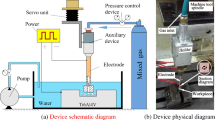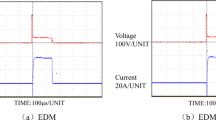Abstract
In the process of electrical discharge machining (EDM) ablation, discharge energy can heat the materials, activate the surface, and eliminate metal corrosion. We study the discharge energy by building an ablation machining energy model. We show that in theory, the magnitude of the discharge energy directly determines the processing speed of ablation milling. Based on single-pulse discharge experiments, we observe an exponential increase in the EDM ablation pit diameter with increasing discharge energy. The ablation pit model is built to study the effect of the discharge energy on the ablation pit depth. The effect of discharge energy on the material removing rate (MRR), electrode wear rate (EWR), and surface roughness rate (Ra) of the EDM ablation was studied in this paper. The results show that, on one hand, the material removing rate (MRR) and surface roughness (Ra) have a direct relationship with the discharge energy. On the other hand, the electrode wear rate (EWR) has an inverse relationship with the discharge energy.
Similar content being viewed by others
References
Kunieda M, Yoshida M, Taniguchi N (1997) Electrical discharge machining in gas. CIRP Ann Manuf Technol 46(1):143–146
Puthumana G, Joshi S (2011) Investigations into performance of dry EDM using slotted electrodes. Int J Precis Eng Manuf 12(6):957–963
Curodeau A, Richard M, Frohn-Villeneuve L (2004) Molds surface finishing with new EDM process in air with thermoplastic composite electrodes. J Mater Process Technol 149(1–3):278–283
Xu MG, Zhang JH, Zhang QH (2009) Material removal mechanisms of cemented carbides machined by ultrasonic vibration assisted EDM in gas medium. J Mater Process Technol 209(4):1742–1746
Zhang QH, Zhang JH, Ren SF, Deng JX, An X (2004) Study on technology of ultrasonic vibration aided electrical discharge machining in gas. J Mater Process Technol 149(1-3):640–644
Tao J, Shih AJ, Ni J (2008) Experimental study of the dry and near-dry electrical discharge milling processes. J Manuf Sci Eng 130(1):11002
Gu L, Zhao WS, Zhang ZH, Kang XM (2006) Mist-Jetting-ED-Milling and its mechanism. Electromachin Mould 02:1–4
Tang CJ, Kang XM, Zhao WS (2008) Experimental study of submersed gas-jetting EDM. Electromachin Mould 03:16–20
Ding LS, Kang XM, Zhao WS (2009) Surface modification of titanium alloy through electrical discharge machining (EDM). Electromachin Mould 04:6–8
Wang XZ, Liu ZD, Xue RY, Tian ZJ, Hang YH (2013) Research on self-mixed oxygen in discharge gap to improve the processing characteristics of titanium alloy electrical discharge machining. Acta Aeronaut Astronaut Sin 34(10):2419–2426
Liang CH, Zhou JP, Zhu ZJ, He Y (2007) Study and application of short arc large current working technology. Mod Manuf Eng 12:92–93
Zhang HY, Zhou JP, Liang CH, Tan JP (2008) Discussion on short arc mechanism of processing technology based on analysis of EDM. Manuf Technol Machine Tool 11:38–42
Abdulkareem S, Khan AA, Konneh M (2009) Reducing electrode wear ratio using cryogenic cooling during electrical discharge machining. Int J Adv Manuf Technol 45(11-12):1146–1151
Sánchez HT, Estrems M, Faura F (2011) Development of an inversion model for establishing EDM input parameters to satisfy material removal rate, electrode wear ratio and surface roughness. Int J Adv Manuf Technol 57:189–201
Wang XZ, Liu ZD, Qiu MB, Hui ZG, Tian ZJ, Huang YH (2014) Mechanism of electrical discharge machining ablation. Mater Manuf Process 29(11-12):1367–1373
Wang XZ, Liu ZD, Qiu MB, Tian ZJ, Huang YH (2014) Research on the influence of gas pressure on the EDM Ablation of titanium Alloy. Acta Aeronaut Astronaut Sin 35:1–9
Zhang WY (1995) Welding metallurgy (fundamental). China Machine Press, Beijing
Li MH (1989) Theoretical basis of EDM. National Defence Industry Press, Beijing
Author information
Authors and Affiliations
Corresponding author
Rights and permissions
About this article
Cite this article
Liu, Z., Wang, X. & Cao, Z. Influence of discharge energy on EDM ablation. Int J Adv Manuf Technol 83, 681–688 (2016). https://doi.org/10.1007/s00170-015-7623-z
Received:
Accepted:
Published:
Issue Date:
DOI: https://doi.org/10.1007/s00170-015-7623-z




